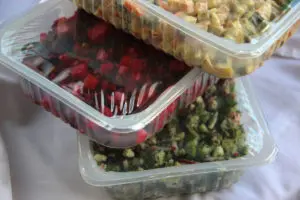BLOG | MAP technology
What is Modified Atmosphere Packaging?

Technology has evolved enough to offer a great number of improvements for the food industry. For instance, when it comes to fresh produce or meat, one of the problems you can often find yourself against is reduced shelf life.
This characteristic of these types of food would make you have to consume them shortly after buying them in the supermarket or let them expire on your shelf and become non-consumable.
But that’s where modified atmosphere packaging (or MAP, for short) comes in. This anti-oxidation and anti-contamination process conserves fresh food for longer, extending the shelf life of several products.
Such technology is proven beneficial to both food suppliers and customers equally. MAP protects food in such a way that it can spend longer periods of time waiting to be sold at the supermarket, or waiting to be consumed at your home.
With the assistance of modified atmosphere packaging, consumers will have a better chance of eating healthy with less difficulty and suppliers will have better chances of selling natural products.
What is Modified
Atmosphere Packaging?
Modified Atmosphere Packaging (MAP) consists of protecting fresh food by controlling or modifying the atmosphere that surrounds it. This new atmosphere can be composed by a new makeup of atmospheric gasses that will reduce oxidation – and other natural processes –, and will be contained within a special package or mixture of various types of films.
The new set of gasses, combined with the film packaging, offers better conditions for preventing the spoilage of perishable food and even some types of beverages.

However, the use of gasses isn’t always necessary. In some cases, the process will involve only the application of a special film to wrap the product. In this method, a new atmosphere is developed naturally by the product’s “new” respiration and the liberation of gasses.
In their own way, both actions create a new atmosphere for the product, hence the name of the process.
Gas Flushing
This is perhaps the most common type of MAP packaging implemented by food suppliers nationwide. It consists of using MAP equipment to exchange ambient atmosphere with new gas and sealing it.
By putting this method into action, you manage to:
- Reduce oxidation
- Decrease the possibility of unwanted microorganism growth (yeasts, molds, bacteria, etc.)
By accomplishing that, you’re able to extend the shelf life of products significantly.
This particular method is massively utilized, along with the barrier packaging films method, by fruit and vegetable sellers. There’s a very big chance that you, at some point in your food shopping, grabbed a pepper, some grapes, or even strawberries that went through the MAP process and put it inside your shopping cart.

Barrier Packaging Films
The application of specific films is also extremely important for the whole MAP process and to create a protective atmosphere for fresh products. In this particular method, you won’t have to add any new gasses to the product’s atmosphere, only caring about appropriately using the barrier packaging.
While standard plastic bags have naturally high oxygen transmissions levels, barrier packaging films can be made of polyethylene (LPDE) and polyvinyl chloride (PVC), or polypropylene (PP), which are all materials that reduce transmission levels of both oxygen and moisture.
This method, along with gas flushing, is also heavily used in the food industry to protect many different types of foods. Some examples of food that can find these types of bags covering are:
- Dry fruits
- Chocolate snacks and bars
- Coffee
- Dog food

How Does Modified Atmosphere Packaging Extend Shelf Life?
What MAP packaging does, essentially, is to provide a safe barrier for food. This is done by preventing unnecessary exposure to oxygen and other contaminants.
There’s a reasonable number of elements that can negatively impact the shelf life of fresh edible products, which are all neutralized by MAP. Some of these elements are:

Light
You’d be surprised about how sensitive to degradation fresh food actually is. It’s sensible enough to have its shelf life compromised by excessive light exposure, in a process called photodegradation. Too much light (for too long) can affect foods’ vitamins, pigments, and proteins, causing unwanted flavor and color changes.

Temperature
High-temperature levels can considerably increase the rate at which chemical reactions in fresh food occur. Some of these (unwanted) reactions include oxidation and enzyme actions. The heat can also cause a negative impact on food’s overall appearance, which decreases consumers’ desire for the product.
MAP packaging often involves placing your packaged products in environments with a regulated temperature, leaning towards colder temperatures.

Moisture
Water, to a certain extent, can be extremely beneficial to fresh food. However, excess moisture is, most of the time, a big no-no when it comes to preserving edible products. The water you actually want from fruits and vegetables is already inside of them, and controlling the moisture and humidity of the product’s packaging is essential to prevent microorganisms or mold growth.
This problem can also frequently happen to food products derived from grain, like bread.
Is There a Modified Atmosphere Packaging Machine?
As for MAP equipment, there are machines for many different production and commercialization circumstances. Most of the machines will offer the option of working with pre-made plastic containers that come in several different shapes and sizes. You can store your products in square, round, or even triangular formats, as well as in bowls or cups.
This type of variation enables food suppliers to really vary their options when it comes to selecting the food products they will put through the MAP process. Also, it allows the actual packaging to not seem odd or inadequate for specific products. Every option will find its match.
There is a certain type of equipment for different production scales as well. There are appropriate machines for packaging fresh food at a medium to large capacity and others are recommended for low at a small to medium capacity.
More advanced models are able to automate many of the manual processes saving time and money, especially with larger-scale operations. For instance, high-end fully automatic MAP machines can package 12,000+ trays per hour with consistent seals and gas residuals.
Let MAPtech Help You!
Here at MAPtech, you’ll be offered three types of MAP machines, all specially developed for implementing the modified atmosphere packaging process into your business. Each machine is recommended for a different scale of business, and all features and specifications must be consulted before moving on with your purchase.
To learn more about our MAP models, check out our equipment page or contact us!
Recent Posts

How does MAP Packaging protect food?
How Does Modified Atmosphere Packaging Protect Food? Modified atmosphere packaging

MAPtech Packaging is Certified by the Women’s Business Enterprise National Council
Maptech Packaging is proud to announce our national certification as

The Freshness Facts of Modified Atmosphere Packaging
Why Modified Atmosphere Packaging? Today’s families are rejecting fast food meals

Jennifer Pfuhl Takes the Helm at Maptech Packaging, Inc.
Hilton Head Island, SC, November 1, 2017 – Maptech Packaging,
Work With The Industry Leader in Extended Shelf Life
Connect with one of our expert team members about how we can bring your packaging dreams to life.



